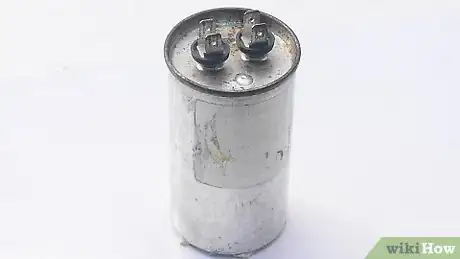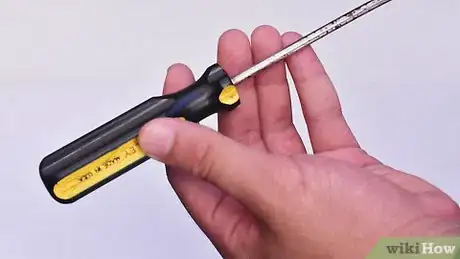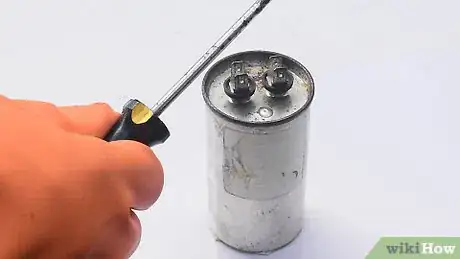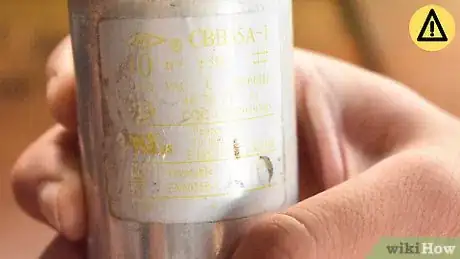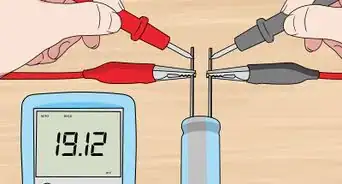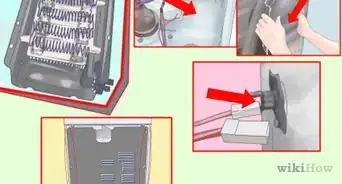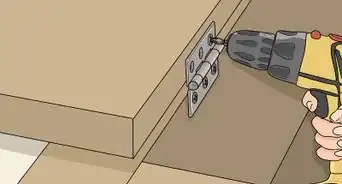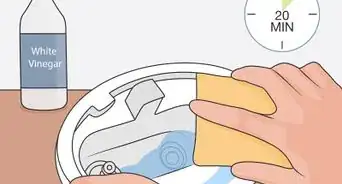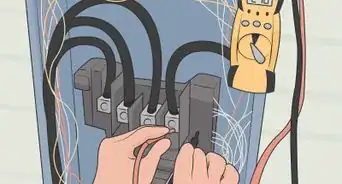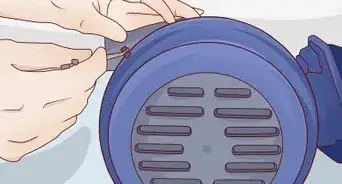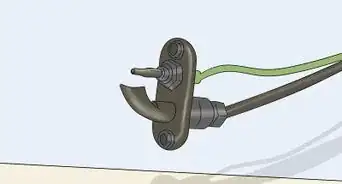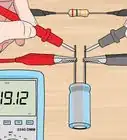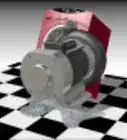This article was co-authored by Daniel Stoescu and by wikiHow staff writer, Hunter Rising. Daniel Stoescu is a Master Electrician and the Owner and Operator of Home Tech Solutions, LLC in Hampton, Virginia. With over a decade of experience, Daniel specializes in wiring residential, commercial, and light industrial structures. The Home Tech Solutions team has over four decades of combined experience and offers comprehensive solutions for residential electrical needs.
There are 14 references cited in this article, which can be found at the bottom of the page.
wikiHow marks an article as reader-approved once it receives enough positive feedback. This article has 12 testimonials from our readers, earning it our reader-approved status.
This article has been viewed 872,501 times.
Start capacitors are used in many home appliances, like washers, refrigerators, or air conditioners. If your appliances are humming but not starting or performing correctly, check the capacitor to see if it’s working properly. By conducting a simple test with a multimeter, you can easily tell if your capacitor is still working or if it needs to be replaced.
Steps
Discharging the Capacitor
-
1Locate the capacitor inside your appliance. Capacitors are metal tubes that store an electric charge usually found near a motor in the appliance. Use a screwdriver to open your machine and locate the capacitor. Use needle-nose pliers with an insulated handle to remove wires.[1]
- Make sure your device is unplugged and turned off before you find the capacitor.
-
2Use a screwdriver with an insulated handle. Find or purchase the screwdriver from a hardware store. The rubber will prevent electricity from traveling through the metal to your hand.[2]
- Use caution when working with electricity. A strong enough shock can cause serious harm or death.
- Make sure the screwdriver’s handle doesn’t have any cracks and that no bit of metal is sticking out the back. This could carry voltage and cause you serious harm.
Advertisement -
3Wear a pair of gloves meant for housework or working with electricity. Since you’re using an insulated screwdriver, work gloves will work fine. For added protection against electricity, use tight-gripping gloves made with rubber.[3]
- Gloves can be purchased at your local hardware or home improvement store.
- Don’t use large rubber gloves because they will give you less dexterity while you’re working.
-
4Hold the handle of the screwdriver so no part of your hand touches the metal. Have a firm grip on the handle, making sure you aren’t in contact with the metal. Even with gloves, the current running through the shaft can cause you harm.[4]
-
5Place the shaft of the screwdriver on the positive terminal. Set the screwdriver down so the terminal contacts the shaft 1 inch (2.5 cm) from the tip. The correct terminal will be marked with a plus sign (+). Make sure the screwdriver doesn’t touch the other terminal on the capacitor yet. [5]
- On a capacitor with more than 2 terminals, the positive terminal may be labeled “common” instead.
-
6Tap the negative terminal with the tip of the screwdriver. While maintaining contact with the positive terminal, tilt the screwdriver so you make contact with the negative terminal. Once you make the connection, you’ll hear a small pop and see a spark on the tip of the screwdriver. Don’t be alarmed; this is the capacitor discharging completely.[6]
- Do not hold onto the metal part of the screwdriver while making the connection. Capacitors can store a lot of energy and the resulting spark or current can result in serious injury.
-
7Connect the terminals again to remove any residual charge. After the initial spark, keep the screwdriver on the terminals and tap the negative side with the tip 1 or 2 more times. Sometimes, leftover charge is still left in the capacitor.[7]
Using a Multimeter
-
1Use the capacitance setting on a digital multimeter. Multimeters are electronic devices that read the voltage and capacitance of circuits or batteries. Find a multimeter with a dedicated capacitance setting for the most accurate readings.[8]
- Make sure the capacitor you’re testing is completely discharged or the circuit is off before using a multimeter. Too high of a voltage can damage the meter or cause you harm.[9]
- Digital multimeters can be purchased hardware or home improvement stores.
- Capacitance is measured in farads (F).
-
2Place the red probe on the positive terminal and the black probe on the negative. Hold the probes by their base without touching the metal pins on the end. Once both probes come into contact with the terminals on your capacitor, the readout on your multimeter will start to change. [10]
- Wear gloves while testing with a multimeter if you’re worried about any residual charge.
-
3Hold the probes in place until the numbers stop changing. The numbers will fluctuate for a few seconds after you connect the terminals if the capacitor is good. Wait until the readout has the same number for 5 seconds before disconnecting the probes.[11]
- Write down the capacitance number after you take a measurement so you can remember it.
- If the numbers do not move at all, the capacitor is considered open and needs to be replaced.
-
4Ensure the reading matches the range of numbers on the capacitor. The minimum and maximum capacitance are listed on the side of the capacitor with all of its other information. The acceptable range depends on the size of the capacitor you have. If the capacitor is above or below the range, it will have to be replaced.[12]
- If the capacitance number went up infinitely to the limit of your multimeter, the capacitor has shorted out and should be replaced.
- Some capacitors will have a set capacitance with an acceptable percentage of variance. For example, if your capacitor says “50 ±5%,” the acceptable capacitance range is 47.5 to 52.5 F.
Community Q&A
Did you know you can get answers researched by wikiHow Staff?
Unlock staff-researched answers by supporting wikiHow
-
QuestionHow do I tell if my capacitor is faulty?
 wikiHow Staff EditorThis answer was written by one of our trained team of researchers who validated it for accuracy and comprehensiveness.
wikiHow Staff EditorThis answer was written by one of our trained team of researchers who validated it for accuracy and comprehensiveness.
Staff Answer wikiHow Staff EditorStaff Answer
wikiHow Staff EditorStaff Answer -
QuestionHow do i check a start capacitor if my A/C is starting on the heat setting and shutting off after a few minutes?
 wikiHow Staff EditorThis answer was written by one of our trained team of researchers who validated it for accuracy and comprehensiveness.
wikiHow Staff EditorThis answer was written by one of our trained team of researchers who validated it for accuracy and comprehensiveness.
Staff Answer wikiHow Staff EditorStaff Answer
wikiHow Staff EditorStaff Answer -
QuestionHow can I tell the high and low parts of a capacitor?
 Community AnswerYou can use a DMM for this purpose. Connect the probes to the terminals of the charged capacitor. If the reading shows a minus sign then you've connected the positive probe to the negative terminal of the capacitor.
Community AnswerYou can use a DMM for this purpose. Connect the probes to the terminals of the charged capacitor. If the reading shows a minus sign then you've connected the positive probe to the negative terminal of the capacitor.
Warnings
- Make sure the screwdriver you use doesn’t have cracks in the handle or exposed metal coming out of the back side.⧼thumbs_response⧽
- Never touch the terminals of a capacitor with your bare hands in case it has a charge. Treat every capacitor as if it had voltage.[14]⧼thumbs_response⧽
Things You’ll Need
Discharging the Capacitor
- Screwdriver with insulated handle
- Needle-nose pliers
- Work gloves
Using a Multimeter
- Digital multimeter
References
- ↑ https://youtu.be/_LbyaaXiitQ?t=2m2s
- ↑ https://youtu.be/ZTQi5rTJIw8?t=2m17s
- ↑ https://youtu.be/ZTQi5rTJIw8?t=2m49s
- ↑ https://youtu.be/ZTQi5rTJIw8?t=3m32s
- ↑ https://youtu.be/ZTQi5rTJIw8?t=3m51s
- ↑ https://youtu.be/ZTQi5rTJIw8?t=4m10s
- ↑ https://youtu.be/ZTQi5rTJIw8?t=4m55s
- ↑ https://youtu.be/hdN0AHzEMAU?t=7s
- ↑ https://web.ua.es/docivis/magnet/multimeter.html
About This Article
To check a start capacitor, start by turning off and unplugging your appliance. Then, use a screwdriver to open the appliance so you can locate the capacitor, which is a metal tube that should be near the motor. Wear work gloves and use a screwdriver with an insulated handle so you don't shock yourself. Once you've found the capacitor, place the shaft of the screwdriver on the positive terminal and tap the negative terminal with the tip to discharge the capacitor. To learn how to use a multimeter to check the capacitor, scroll down!
